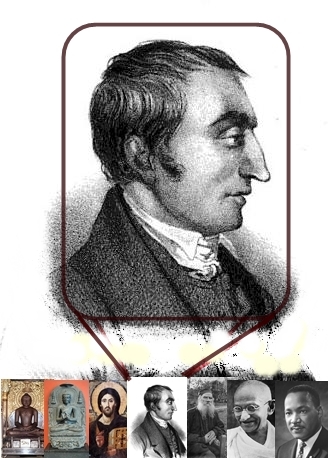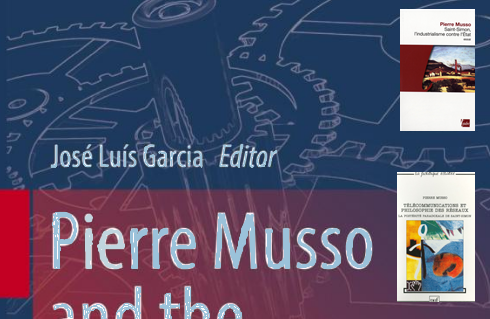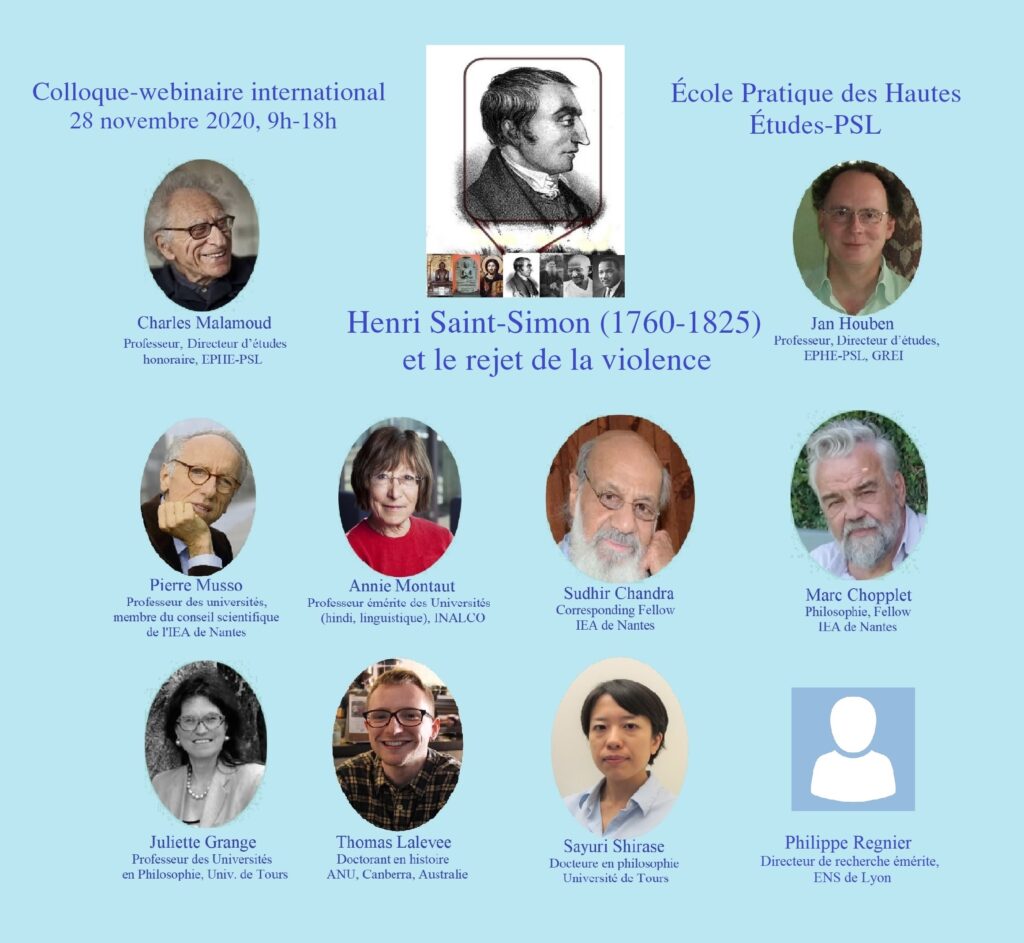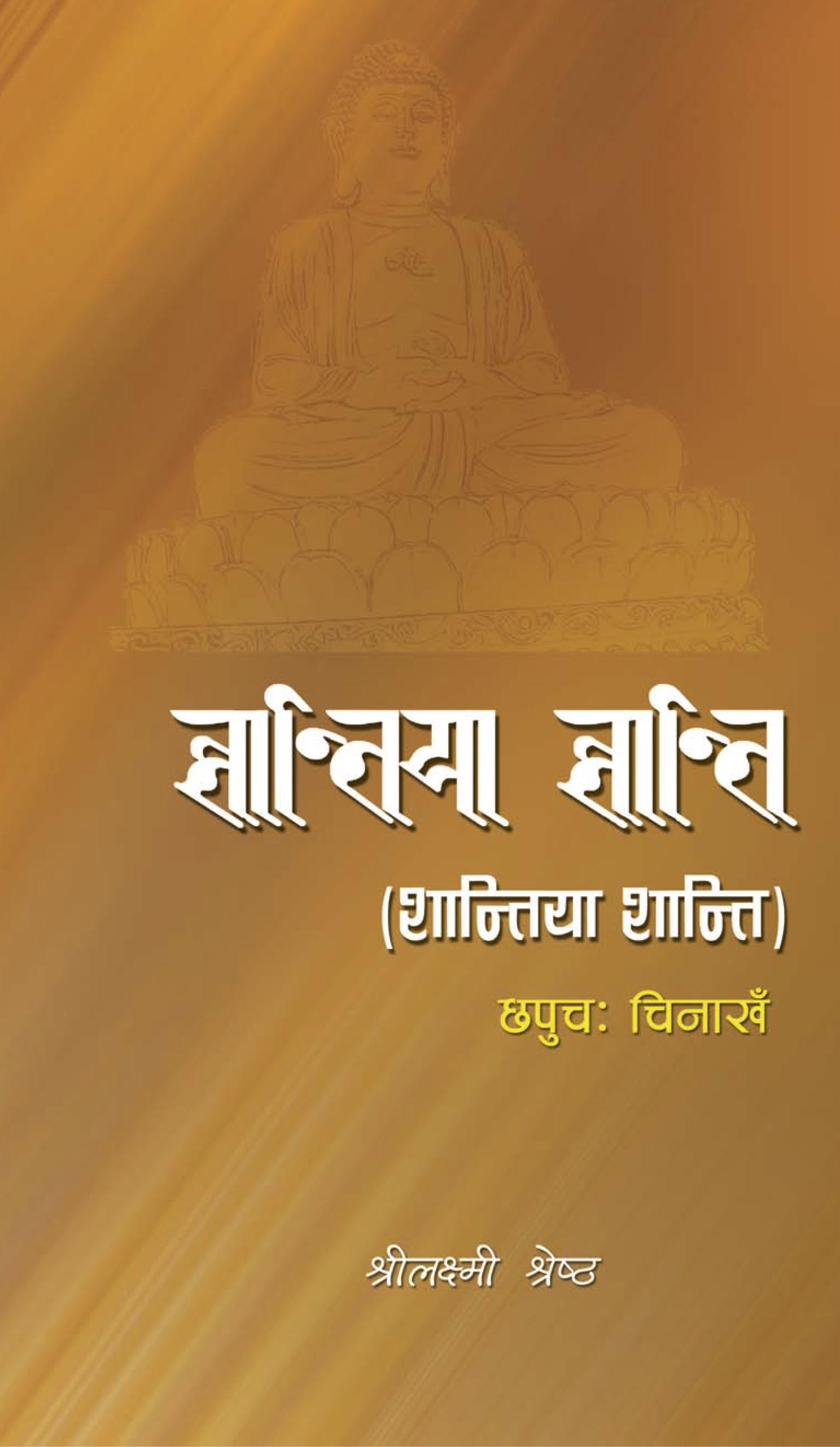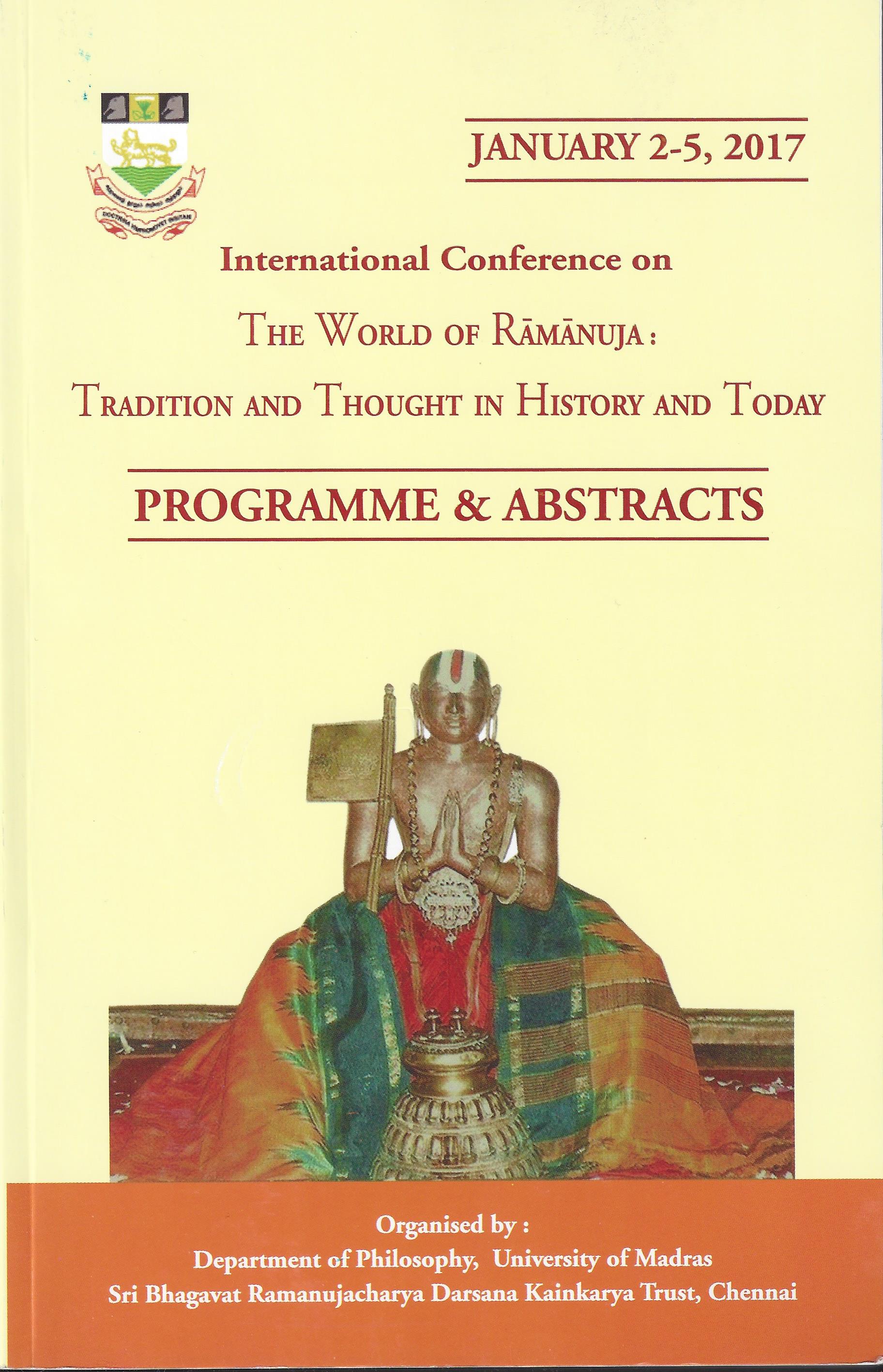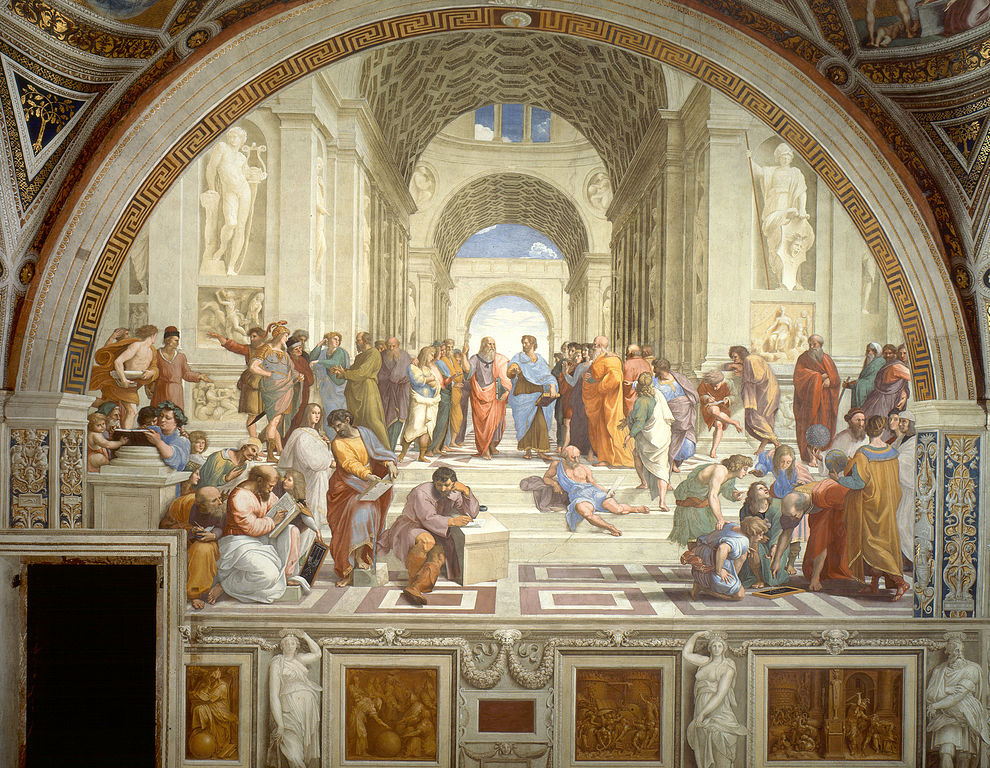Managing Memes for Peace and Progress
Research for Well-founded Memes
Henri Saint-Simon (1760-1825) et le rejet de la violence: colloque-webinaire le 28 novembre 2020
Dans ce colloque, plusieurs aspects de la pensée de Saint-Simon et de ses disciples seront analysés, et comparés et contrastés notamment avec la philosophie du Mahatma Gandhi et les mouvements inspirés par lui. Pour plus d’informations et pour vous inscrire cliquez ICI. Les contributeurs au colloque:
PROGRAMME — pour plus d’informations et pour vous inscrire cliquez ICI.
9h00 (9h05-9h25) Note d’introduction par Charles Malamoud, Directeur d’études honoraire, EPHE-PSL
9h30 (9h30-10h10) Pierre Musso, Professeur des Universités, membre du conseil scientifique de l’IEA de Nantes, “Les quatre fondements de la non-violence chez Saint-Simon”
10h15 (10h15-10h55) Sudhir Chandra (INDE: +4h30!>>>14h45-15h20), Corresponding Fellow IEA de Nantes, “Since Gandhi: Growing Anxiety about Non-Violence”
11h00 (11h00-11h40) Thomas Lalevee (AUSTRALIE+10!>>>21h00-21h40), Doctorant en histoire à l’Australian National University (ANU), Canberra, Australie, “De l’homme à la nature: Saint-Simon et la question de la domination sociale.”
11h45 (11h45-12h25) Sayuri Shirase (JAPON+8!>>>19h45-20h25)Docteure en philosophie (Université de Tours, 2019), “Rejet de la conquête et justification de l’autodéfense. Projet d’administration industrielle par Henri Saint-Simon”
pause midi 12h30-13h30
13h30 (13h30-14h10) Annie Montaut, Professeur émérite des Universités (hindi, linguistique), INALCO, “Des décapités du Rajasthan aux pendus du Bihar: difficile non-violence”
14h15 (14h15-14h55) Marc Chopplet, Philosophie, Fellow IEA de Nantes 2015-2016. “Charles Lemonnier (1806-1891) : Les Etats-Unis d’Europe, comment assurer la paix en Europe?”
15h00 (15h00-15h40) Philippe Regnier, Directeur de recherche émérite, ENS de Lyon, “Autour de 1830, en France: l’utopie saint-simonienne d’un monde désarmé”
15h45 (15h45-16h25) Juliette Grange, Professeur des Universités en Philosophie, Université de Tours, “Paix et européanisme chez Saint Simon et Comte”
16h30 (16h30-16h55) Jan Houben, Directeur d’études, EPHE-PSL, GREI, “La ‘magie’ de la non-violence: quelques textes peu connus de l’Inde ancienne”
17h00 (17h00-17h45) Table Ronde
*** *** *** *** ***
Some background information:
BORN 260 YEARS AGO, on 17 October 1760, Henri Saint-Simon (1760-1825) was a non-violent transformative activist of the late eighteenth – early nineteenth century. A survivor of the French Revolution, he had understood that violence in itself does not transform a society. When all real or imagined ‘opponents’ of the desired or imagined transformation have been killed, new persons will again fill in the empty slots of power-relations of the old system.
(By Jan E.M. Houben, EPHE-PSL, for Memepeace.org, simultaneously published on LinkedIn — https://www.linkedin.com/pulse/born-260-years-ago-17-october-1760-henri-saint-simon-1760-1825-jan )
Among rational actors the rejection of violence is quite general if not universal, but controversy emerges, in many or all cultures, as to which circumstances, if any, would justify the use of some amount of violence for the sake of achieving a higher ‘good’ (Houben and van Kooij 1999; Houben 1999). A survivor of the French Revolution, Henri Saint-Simon (17 October 1760 – 19 May 1825) had understood very well that violence in itself does not transform a society. When all real or imagined ‘opponents’ of the transformation have been killed, the empty slots of the power-relations of the old system are again filled up by new individuals. Something else is needed to go beyond the out-dated, in Saint-Simon’s time, feudal-military power-relations, and to make a transition to a new and better society based on new understandings of the world and making use of new technologies and new networks. Henri Saint-Simon’s rejection of violence was deliberate, and his will to achieve the original idealistic aims of the French Revolution was passionate. Saint-Simon’s rejection of violence, on the basis of what he had witnessed in the French Revolution, is all the more significant in the light of the glorification of violence as a means to realize a utopian society around half a century later by Karl Marx and Friedrich Engels, later on by Vladimir Lenin, who referred to the violence of the French Revolution as an example to be followed or surpassed.
For those who accept violence as an evil but necessary ‘means’ to achieve the sacred purpose of one’s favourite ‘ideal (socialist) state’ it is difficult to argue against – it is difficult to claim a convincing moral basis to argue against – others who want to use the same ‘evil but necessary’ means to achieve their ‘ideal (fascist) state’ or to achieve their ‘ideal (islamist) state’. It may happen, and it has actually happened in Russia in the second decade of the twentieth century, that a revolution is started to prepare the way for one ‘ideal state’ but that this finally leads to the realization of an entirely different ‘ideal state’. George Sorel’s glorification of violence as a means to realize socialism (1908) turned out to be a source of inspiration not only for later generations of socialists and communists but also for fascists. However, although concepts of non-violence (ahiṁsā) and concepts of non-violent resistance and activism in the modern world (Martin Luther King, Nelson Mandela, etc.) are often traced back, to a considerable extent, to the life and work of Mahatma Gandhi and to Indian cultural history, the western tradition too had its early modern thinkers who rejected violence and reflected on other methods to realize one’s cherished political goal: an important one among these is Henri Saint-Simon.
These points are largely lost in modern studies of Henri Saint-Simon, born as Claude Henri de Rouvroy, Duke of Saint-Simon, who, inspired by the ideals of the French Revolution in its early days, gave up the privileges and titles of nobility of his own free will (see now also Musso 2020). In memorable discussions I had with one of the greatest modern specialists of Saint-Simon, the French philosopher Pierre Musso, during my stay at the Institut d’Etudes Avancés in Nantes (2015-2016) and afterwards, I have occasionally asked more information on Saint-Simon’s view on a topic which has interested me since long: violence and non-violence. Pierre Musso has now put together his observations on this subject (Musso 2018). Musso not only co-edited the complete works of Saint-Simon (Edition critique des Œuvres complètes de Saint-Simon, Paris: PUF, 2013), but he also wrote several works on this remarkable thinker and, we may say at present, activist for a better society, at a time that ‘activism’ was not yet in fashion. Saint-Simon may be regarded as the grandfather not only of several modern ideologies, but also of sociology as a scientific discipline, as he was the teacher and inspirator of Auguste Comte (1798-1857).
In his recent study (2018), Pierre Musso distinguishes four dimensions of the subject of violence and the rejection of violence in the life and work of Saint-Simon:
(a) the experience of violence during the years 1780-1815;
(b) his position that the cause of violence in the then current feudal-militaristic system was the government;
(c) the alternative and opposite to the violence of the government is work, industry and science;
(d) his ideas on changing society without violence: a theory of transition.
In addition, Musso discusses Saint-Simon’s position that the state should dismiss its professional army and have only a “ ‘defensive’ conscripted army composed of ‘soldier-citizens’ ” (Musso 2018: 141).
The importance of Saint-Simon for the discipline of sociology was duly appreciated by Emile Durkheim (1858-1917). Saint-Simon invented the concept of industrialism to designate industrial societies. James Burnham and Daniel Bell regard him as the father of technocratism and management. Saint-Simon wanted to minimize the role of the state in economic life and also, as said, reduce armies to a minimum, so that Proudhon could see him as one of the precursors of anarchism. Karl Marx conveniently circumvented Saint-Simon’s conscious rejection of violence as a means to change societies by classifying him as a ‘utopian’ socialist.
A crucial insight of Saint-Simon was that real social change will come about only if relationships and networks of relationships change. However, the “Revolution remained unfinished, which proved that the violence employed was useless. The promiss of social change was not fulfilled. Quite the contrary, what the Revolution led to was the Napoleonic Empire and, later, the Restoration of monarchy” (Musso 2018: 128-129). In a later analysis of the Revolution and its failures, Saint-Simon estimated that “If the French revolutionaries ‘had dismissed their armies […], they would have been ensured liberty forever within and tranquility outside’ ” (Musso 2018: 141).
Saint-Simon “established the opposition between war and industry … by radically contrasting the two social systems: the ‘feudal-military’ [rule] of the Ancien Régime, which endured despite the Revolution, and the newly emerging ‘industrial system’, which he attempted to define and to bring about” (Musso 2020: 126). The old ‘feudal-military’ regime remained in power, according to Saint-Simon, “through force and trickery” (Musso 2018: 131), and there was a need to seek a passage to a new system of “administration through work and industry” (Musso 2018: 126), non-violently, because violence cannot establish a new system. To achieve such a passage to the desired and required new system, “Saint-Simon saw demonstration, persuasion and conviction as forces likely to overcome violence and ignorance” (Musso 2018: 140).
Demonstration and persuasion play such an important role because, “Against the physical and military force of the rulers, Saint-Simon opposes the power of public opinion, which ‘is, as the proverb says, the queen of the world. No force can resist it.’ ‘Bayonets’, he declared, ‘have no power over opinions’.” (Musso 2018: 133). To popularise his ideas and to disseminate his doctrines, Saint-Simon hence published numerous articles and images, especially in the years 1819-1820, in Le Politique and in L’Observateur (Musso 2018: 135). The importance attributed by Saint-Simon, in word and deed, to the seemingly weak forces of “demonstration and persuasion” even in the face of physical violence or threats of physical violence, would go well with the importance attributed to ‘communicative action’ in the philosophy of Jürgen Habermas (1981). The success of a transformation of contemporary societies, then, would not be determined by violence in itself, but rather by factors such as the size and intensity of the participation through communicative action of the community concerned. In this connection it has been found (Dudouet & Clark 2009) that, rather than armed strategies, it is nonviolent resistance and activism which require the active communicative participation of the largest part of a society. The fact that this ‘communicative action’ is to a very large extent ‘imbued’ with language – as both Habermas and the ancient Indian grammarian-philosopher Bhartṛhari would argue – contributes to the richness of its cultural forms (Houben 2020), which may, however, if insufficiently recognized, also contribute to a perpetuation of misunderstandings and conflict situations.
In addition, Saint-Simon expected a drastic change towards peaceful conditions by giving a significant influence on decisions regarding taxation and the national budget to … “industrial chiefs” (Musso 2018: 139), which must have meant, at the very beginning of the industrial revolution, heads of factories and leaders of industrial workshops. In Saint-Simon’s view, “In cooperation, where everybody provides a capacity and a commitment, there is real association […]. Such is the fundamental nature of industrial societies” (Musso 2018: 134).
Saint-Simon not only explored the conditions for the scientific study of ‘societies’ and inspired August Comte to define the beginnings of sociology, he also inspired a group of thinkers and doers who considered themselves, explicitly, Saint-Simonians. In this connection a volume must be mentioned which is specially devoted to Pierre Musso and the Network Society: from Saint-Simonianism to the Internet (Cham, Switzerland: Springer, 2016), edited by José Luís Garcia, consisting of 9 chapters by several authors, including an Introductory chapter by the editor and two contributions by Pierre Musso, chapter 2 “Network Ideology: from Saint-Simonianism to the Internet” and a Final Note “Examining the Network Concept”. Here we see, in a way, a development of the philosophy of the ‘industrial system’ of Saint-Simon and the Saint-Simonians which implicitly opposes and steers away from the violence of the old ‘feudal-military’ conditions. A crucial concept in several ‘revolutions’ from a Saint-Simonian perspective as here discussed by Pierre Musso is the ‘network’. In his chapter, Pierre Musso distinguishes three ‘industrial revolutions’ in the last two centuries, each of which “relied upon the formation of a large territorial technical network (my emphasis, JH): the railways (the railway network, JH), with the first ‘industrial revolution’ (1780-1830), the electrical network (my emphasis, JH), with the second ‘industrial revolution’ (1880-1930), and finally the Internet network (my emphasis, JH), spawned by the convergence of telecommunication and information technology.”
Pierre Musso highlights in this chapter as in earlier books (1998, 2010) that “Many myths, fictions, images and imaginaries have always surrounded the development of major technical networks, with the purpose of socializing them.” Technology itself appears as a new divinity, and “the Internet is but one of its luminous apparitions.” Musso recognizes six markers of Network Techno-Utopia, which can be recognized already in the work of Saint-Simon and which have since been developed and re-applied to new ‘industrial revolutions’: (1) the association of the network and the brain, in the track of Galen and Descartes; (2) “The second marker of the network is not so much Cartesian as Leibnizian; it signals that the network can be formalized”; (3) The third marker is most evident in the Manifesto of Michel Chevalier, follower of Saint-Simon: “the technical network always announces a technical and therefore social revolution, through the fragmentation of the existing social structure and the promise of modernity in the future. The network transforms society: electricity, IT, tele-communications, transport or the Internet produce ‘post’ societies (post-modern, post-industrial, etc.)” (4) “Networks contribute to peace, prosperity and universal association, as they artificially cover the Earth.” (5) “The network is an answer to crisis, by ensuring economic development and prosperity … it bears the promise of new occupations, and a new cycle of growth.” (6) “A choice of society or policy is embedded within the very architecture of the network … Its graph either reveals a monarchical, Jacobin, centralizing policy, or the opposite.” The philosophy of the ‘network’ can hence be expected to be crucial in exploring the possibility of developing a Saint-Simonian approach to creating peace and progress among human beings, specimens of homo reticularis, ‘network man’, who, as has always been the case but as is becoming ever more clear in the age of social media, exists and is defined, and re-defined, by his networks.
The 260th birthday of Henri Saint-Simon takes place in the middle of an unprecedented, world-wide health and medical technology crisis: the Corona or Covid-19 crisis. The Corona-virus was perhaps the first to make full use of all modern transportation networks (from railway to airway) to reach, more or less, the entire population of the globe. The upheaval it created and still creates has challenged humanity on an unprecedented scale to make, in turn, full use of all networks and technologies of transport and communication it has at its disposal in order to overcome the virus and to restore humanity’s health perspectives to where they were before the crisis. The Corona crisis has also exposed, directly or indirectly, undesirable power relations that have led to both nonviolent and violent protests, which in some cases were given the space they deserved but in others were responded to violently. It is hoped that major actors in these conflicts will familiarize themselves with the examples and teachings of Henri de Saint-Simon – his well-considered rejection of violence and the alternative ways towards transformation developed and demonstrated by him and his successors – and will succeed in lifting the conflicts to a higher level of communicative action, so that unnecessary and counterproductive violence can be avoided in the search for fair solutions.
Several of the deepest dreams of Henri Saint-Simon are now reality, but the outcome is perhaps not always as he would have expected. In most modern democracies leaders of industry have, in one way or the other, significant influence on government decisions. They will normally require and be in favour of peaceful conditions, but Saint-Simon may not have been sufficiently aware of the role of the arms industry which needs both safety for its production but wars for increasing its sales. Nor may he have thought, on the other hand, of the hospitality and tourism industry which not only requires peaceful conditions but also, especially in the case of cultural and linguistic educational tourism, may tend to reinforce these peaceful relationships and networks between people of different countries and background, to the extent that promoting the tourism industry becomes almost tantamount to promoting peace. It is all the more tragic that precisely this hospitality and tourism industry is among the most affected branches of the economy in the current Corona crisis… In order to spread his message, Henri Saint-Simon invested much time in formulating and publishing compact and easily reproducible images and narratives: ‘memes’, which he would no doubt have been happy to diffuse through modern social media if these would have been available in his time.
In understanding and interpreting the work and life of Henri Saint-Simon for writing this brief article, I have based myself primarily on lectures, publications and references given by one of the greatest current specialists of Henri Saint-Simon: the French political scientist and philosopher Pierre Musso.
Published on 17 October 2020
REFERENCES
Charzat, Michel. 1977. Georges Sorel et la révolution au XXe siècle. Paris: Hachette.
Dudouet, Véronique, and Howard Clark. 2009. Nonviolent civic action in support of human rights and democracy. Brussels: European Parliament.
Garcia, José Luís (ed.). 2016. Pierre Musso and the Network Society: from Saint-Simonianism to the Internet. Cham, Switzerland: Springer, 2016.
Habermas, Jürgen. 1981. Theorie des kommunikativen Handelns. Bd. 1: Handlungsrationalität und gesellschaftliche Rationalisierung; Bd. 2: Zur Kritik der funktionalistischen Vernunft. Frankfurt am Main: Suhrkamp.
Houben, Jan E.M. 2020. “The art of grammar in context: ‘Science’, human interest, and the construction of cultural and political worlds.” In: Science and Scientification in South Asia and Europe (ed. by Axel Michaels and Christoph Wulf), pp. 13-41. Oxon/New York: Routledge.
———-. 1999. “To kill or not to kill the sacrificial animal (yajña-paśu)? Arguments and perspectives in Brahminical ethical philosophy.” In: Violence Denied: Violence, Non-Violence and the Rationalization of Violence in South Asian Cultural History (ed. by J.E.M. Houben and K.R. van Kooij), 105-183. Leiden: E.J. Brill.
Houben, Jan E.M. and K.R. van Kooij. 1999. “Introduction: violence, non-violence and the rationalization of violence in South Asian cultural history.” In: Violence Denied: Violence, Non-Violence and the Rationalization of Violence in South Asian Cultural History (ed. by J.E.M. Houben and K.R. van Kooij), 1-15. Leiden: E.J. Brill.
Musso, Pierre. 2020. Saint-Simon et le saint-simonisme. (Collection: Le philosophe.) (New, updated and revised edition; first edition in Collection: Que-sais-je, Paris: PUF, 1999.) Paris: Manucius.
———-. 2018. “Violence in the Philosophy of Saint-Simon.” In: Violence and Non-Violence across Time: History, Religion and Culture (ed. by Sudhir Chandra): 125-143. Oxon/New York: Routledge.
———-. 2016. “Network Ideology: from Saint-Simonianism to the Internet” In: Pierre Musso and the Network Society: from Saint-Simonianism to the Internet (ed. by José Luís Garcia). Cham, Switzerland: Springer, 2016.
———-. 2010. Saint-Simon, l’industrialisme contre l’Etat (in French). La Tour d’Aigues: Editions de l’Aube.
———-. 1998. Télécommunications et philosophie des réseaux: la postérité paradoxale de Saint-Simon (in French). Paris, PUF. (First edition 1997.)
Saint-Simon, Henri. 2013. Edition critique des Œuvres complètes de Saint-Simon (4 volumes), ed. by Juliette Grange, Pierre Musso, Philippe Régnier & Franck Yonnet. Paris: PUF, 2013.
Sorel, Georges. 1910. Réflexions sur la violence. Deuxième édition (première : 1908). p. 365 : “C’est à la violence que le socialisme doit les hautes valeurs morales par lesquelles il apporte le salut au monde moderne” (“It is to violence that socialism owes its high moral values by which it brings salvation to the modern world,” which we quoted in our Introduction to Violence denied (Houben & van Kooij, 1999: 2, note 1); see also Sorel, ed. by J.L. Stanley, 1976, p. 226; and Charzat 1977.)
———-. 1976. From Georges Sorel: Essays in Socialism and Philosophy. Ed. with an introd. by J.L. Stanley, transl. by J. and C. Stanley. New York: Oxford Univ. Press.
Virtual Project “Fullarbor”
“Fullarbor Desert Greening Lanes” is a virtual project for forestation with a view to contribute to climate stabilization
Peace Creation
Can peace be created positively? Continue reading
Ideodiversity
“Ideodiversity as a planetary value”
Enthusiasm for one’s own favourite political, economic or religious ideology, may inspire a total commitment to spread and make prosper this preferred ideology and, if possible, to make it obtain an absolute victory.
Born 260 years ago: Henri Saint-Simon (1760-1825), non-violent transformative activist
BORN 260 YEARS AGO, on 17 October 1760, Henri Saint-Simon (1760-1825) was a non-violent transformative activist of the late eighteenth – early nineteenth century. A survivor of the French Revolution, he had understood that violence in itself does not transform a society. When all real or imagined ‘opponents’ of the desired or imagined transformation have been killed, new persons will again fill in the empty slots of power-relations of the old system.
Best Wishes on Liberation Day 5 May 2020

(पञ्चसप्ततिवर्षेभ्यः पूर्वम् ) मानवाद्यधिकारोऽपि जनस्य यत्र नाभवत् । घोरातिपापिदूराष्ट्रं ध्वस्तं – तत्कृद्-भ्य आदरः ॥ (Seventy-five years ago : ) “Where people did not have even the most basic human rights, that evil regime of terrible and excessive criminals was destroyed : respect to those who did it.” Jan Houben for MemePeace.org, 5…



